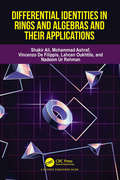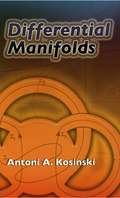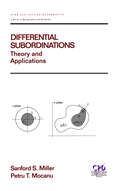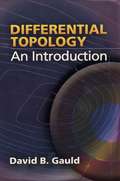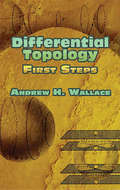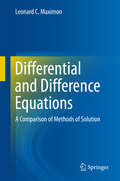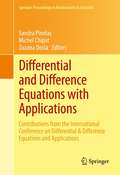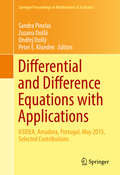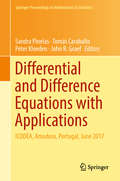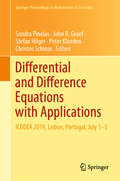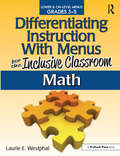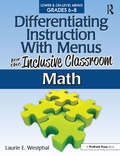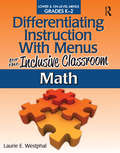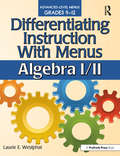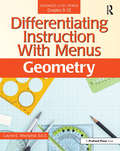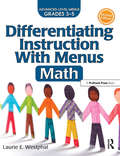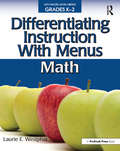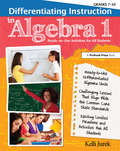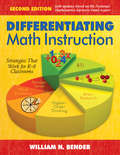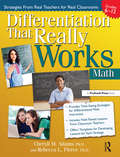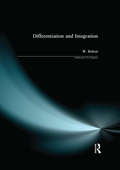- Table View
- List View
Differential Identities in Rings and Algebras and their Applications
by Mohammad Ashraf Vincenzo De Filippis Shakir Ali Lahcen Oukhtite Nadeem Ur RehmanThe theory of differential identities in associative rings and algebras is the basis of this monograph. Informally, an identical relation involving arbitrary elements in the underlying rings (or algebras) along with the unknown differential function is called a differential identity in a ring (or algebra). Invariant theory, non-commutative geometry, mathematical physics, and the theory of rings and algebras are just a few of the fields where this abstract theory has proved to be an effective instrument for solving a wide range of challenging issues, and as the twenty-first century has arrived, the theory of differential identities has found enormous applications in resolving a number of unresolved problems in the theory of rings. This volume summarizes the findings and approaches that have significantly advanced the field during the previous three decades. The first chapter provides a brief introduction to the topic. The following three chapters cover the various kinds of derivations in rings and algebras as well as the interactions between the structure of some classes of rings with involution and the behavior of the underlying derivations, generalized derivations, skew derivations, and b-generalized derivations, as well as their corresponding properties. Chapter 5 explores the characterization of several kinds of higher derivable mappings and the structure of Lie and Jordan-type higher derivations. Although the book contains numerous applications of the conclusions presented in these chapters, the last chapter mostly focuses on the application of derivations. This research monograph is useful for researchers working in the area of differential identities in rings and algebras. It provides a comprehensive and authoritative account of research findings.
Differential Manifolds
by Antoni A. KosinskiThe concepts of differential topology form the center of many mathematical disciplines such as differential geometry and Lie group theory. Differential Manifolds presents to advanced undergraduates and graduate students the systematic study of the topological structure of smooth manifolds. Author Antoni A. Kosinski, Professor Emeritus of Mathematics at Rutgers University, offers an accessible approach to both the h-cobordism theorem and the classification of differential structures on spheres."How useful it is," noted the Bulletin of the American Mathematical Society, "to have a single, short, well-written book on differential topology." This volume begins with a detailed, self-contained review of the foundations of differential topology that requires only a minimal knowledge of elementary algebraic topology. Subsequent chapters explain the technique of joining manifolds along submanifolds, the handle presentation theorem, and the proof of the h-cobordism theorem based on these constructions. There follows a chapter on the Pontriagin Construction--the principal link between differential topology and homotopy theory. The final chapter introduces the method of surgery and applies it to the classification of smooth structures of spheres. The text is supplemented by numerous interesting historical notes and contains a new appendix, "The Work of Grigory Perelman," by John W. Morgan, which discusses the most recent developments in differential topology.
Differential Subordinations: Theory and Applications (Chapman & Hall/CRC Pure and Applied Mathematics)
by Sanford S. Miller Petru T. Mocanu"Examining a topic that has been the subject of more than 300 articles since it was first conceived nearly 20 years ago, this monograph describes for the first time in one volume the basic theory and multitude of applications in the study of differential subordinations."
Differential Topology
by C. T. C. WallExploring the full scope of differential topology, this comprehensive account of geometric techniques for studying the topology of smooth manifolds offers a wide perspective on the field. Building up from first principles, concepts of manifolds are introduced, supplemented by thorough appendices giving background on topology and homotopy theory. Deep results are then developed from these foundations through in-depth treatments of the notions of general position and transversality, proper actions of Lie groups, handles (up to the h-cobordism theorem), immersions and embeddings, concluding with the surgery procedure and cobordism theory. Fully illustrated and rigorous in its approach, little prior knowledge is assumed, and yet growing complexity is instilled throughout. This structure gives advanced students and researchers an accessible route into the wide-ranging field of differential topology.
Differential Topology: An Introduction (Dover Books on Mathematics)
by David B. GauldOffering classroom-proven results, Differential Topology presents an introduction to point set topology via a naive version of nearness space. Its treatment encompasses a general study of surgery, laying a solid foundation for further study and greatly simplifying the classification of surfaces.This self-contained treatment features 88 helpful illustrations. Its subjects include topological spaces and properties, some advanced calculus, differentiable manifolds, orientability, submanifolds and an embedding theorem, and tangent spaces. Additional topics comprise vector fields and integral curves, surgery, classification of orientable surfaces, and Whitney's embedding theorem. Suitable for advanced undergraduate courses in introductory or differential topology, this volume also serves as a supplementary text in advanced calculus and physics courses, as well as a key source of information for students of mechanics.
Differential Topology: First Steps (Dover Books on Mathematics)
by Andrew H. WallaceKeeping mathematical prerequisites to a minimum, this undergraduate-level text stimulates students' intuitive understanding of topology while avoiding the more difficult subtleties and technicalities. Its focus is the method of spherical modifications and the study of critical points of functions on manifolds.No previous knowledge of topology is necessary for this text, which offers introductory material regarding open and closed sets and continuous maps in the first chapter. Succeeding chapters discuss the notions of differentiable manifolds and maps and explore one of the central topics of differential topology, the theory of critical points of functions on a differentiable manifold. Additional topics include an investigation of level manifolds corresponding to a given function and the concept of spherical modifications. The text concludes with applications of previously discussed material to the classification problem of surfaces and guidance, along with suggestions for further reading and study.
Differential and Difference Equations
by Leonard C. MaximonThis book, intended for researchers andgraduate students in physics, applied mathematics and engineering, presents adetailed comparison of the important methods of solution for lineardifferential and difference equations - variation of constants, reduction oforder, Laplace transforms and generating functions - bringing out thesimilarities as well as the significant differences in the respective analyses. Equations of arbitrary order are studied, followed by a detailed analysis forequations of first and second order. Equations with polynomial coefficients areconsidered and explicit solutions for equations with linear coefficients aregiven, showing significant differences in the functional form of solutions ofdifferential equations from those of difference equations. An alternativemethod of solution involving transformation of both the dependent andindependent variables is given for both differential and difference equations. A comprehensive, detailed treatment of Green's functions and the associatedinitial and boundary conditions is presented for differential and differenceequations of both arbitrary and second order. A dictionary of differenceequations with polynomial coefficients provides a unique compilation of secondorder difference equations obeyed by the special functions of mathematicalphysics. Appendices augmenting the text include, in particular, a proof ofCramer's rule, a detailed consideration of the role of the superpositionprincipal in the Green's function, and a derivation of the inverse of Laplacetransforms and generating functions of particular use in the solution of secondorder linear differential and difference equations with linear coefficients.
Differential and Difference Equations with Applications
by Michel Chipot Sandra Pinelas Zuzana DoslaThe volume contains carefully selected papers presented at the International Conference on Differential & Difference Equations and Applications held in Ponta Delgada - Azores, from July 4-8, 2011 in honor of Professor Ravi P. Agarwal. The objective of the gathering was to bring together researchers in the fields of differential & difference equations and to promote the exchange of ideas and research. The papers cover all areas of differential and difference equations with a special emphasis on applications.
Differential and Difference Equations with Applications
by Peter E. Kloeden Sandra Pinelas Zuzana Došlá Ondrej DošlýAimed at the community of mathematicians working on ordinary and partial differential equations, difference equations, and functional equations, this book contains selected papers based on the presentations at the International Conference on Differential & Difference Equations and Applications (ICDDEA) 2015, dedicated to the memory of Professor Georg Sell. Contributions include new trends in the field of differential and difference equations, applications of differential and difference equations, as well as high-level survey results. The main aim of this recurring conference series is to promote, encourage, cooperate, and bring together researchers in the fields of differential & difference equations. All areas of differential and difference equations are represented, with special emphasis on applications.
Differential and Difference Equations with Applications: Contributions From The International Conference On Differential: And: Difference Equations And Applications (Springer Proceedings in Mathematics & Statistics #47)
by John R. Graef Sandra Pinelas Peter Kloeden Tomás CaraballoThis book gathers papers from the International Conference on Differential & Difference Equations and Applications 2017 (ICDDEA 2017), held in Lisbon, Portugal on June 5-9, 2017. The editors have compiled the strongest research presented at the conference, providing readers with valuable insights into new trends in the field, as well as applications and high-level survey results. The goal of the ICDDEA was to promote fruitful collaborations between researchers in the fields of differential and difference equations. All areas of differential and difference equations are represented, with a special emphasis on applications.
Differential and Difference Equations with Applications: ICDDEA 2019, Lisbon, Portugal, July 1–5 (Springer Proceedings in Mathematics & Statistics #333)
by John R. Graef Sandra Pinelas Peter Kloeden Stefan Hilger Christos SchinasThis edited volume gathers selected, peer-reviewed contributions presented at the fourth International Conference on Differential & Difference Equations Applications (ICDDEA), which was held in Lisbon, Portugal, in July 2019. First organized in 2011, the ICDDEA conferences bring together mathematicians from various countries in order to promote cooperation in the field, with a particular focus on applications. The book includes studies on boundary value problems; Markov models; time scales; non-linear difference equations; multi-scale modeling; and myriad applications.
Differential and Integral Inequalities (Springer Optimization and Its Applications #151)
by Dorin Andrica Themistocles M. RassiasTheories, methods and problems in approximation theory and analytic inequalities with a focus on differential and integral inequalities are analyzed in this book. Fundamental and recent developments are presented on the inequalities of Abel, Agarwal, Beckenbach, Bessel, Cauchy–Hadamard, Chebychev, Markov, Euler’s constant, Grothendieck, Hilbert, Hardy, Carleman, Landau–Kolmogorov, Carlson, Bernstein–Mordell, Gronwall, Wirtinger, as well as inequalities of functions with their integrals and derivatives. Each inequality is discussed with proven results, examples and various applications. Graduate students and advanced research scientists in mathematical analysis will find this reference essential to their understanding of differential and integral inequalities. Engineers, economists, and physicists will find the highly applicable inequalities practical and useful to their research.
Differentialrechnung für Höhlenmenschen und andere Anfänger: Die mathematische Behandlung kleinster Änderungen (essentials)
by Jürgen BeetzJürgen Beetz führt zuerst in den Ursprung der erdachten Geschichten der Mathematik aus der Steinzeit ein. Im Anschluss daran stellt er die zentrale Fragestellung der ,,Infinitesimalrechnung" anhand eines einfachen Beispiels dar. Dann erläutert der Autor die Grundproblematik des Differenzierens: die Steigung (d. h. die Richtung der Tangente) an einer beliebigen Stelle einer Funktion y=f(x) festzustellen. Als praktische Beispiele des Differenzierens behandelt er die Hyperbel und die Sinusfunktion. Ein eigenes Kapitel widmet Jürgen Beetz den Besonderheiten der Exponentialfunktion.
Differentiating Instruction With Menus for the Inclusive Classroom: Math (Grades 3-5)
by Laurie E. WestphalDifferentiating Instruction With Menus for the Inclusive Classroom: Math for grades 3-5 offers teachers everything they need to create a student-centered learning environment based on choice. This book provides five different types of menus that students can use to select exciting products that they will develop so teachers can assess what has been learned—instead of using a traditional worksheet format. Topics addressed include whole numbers and operations, fractions, probability and statistics, geometry, and measurement.Differentiating Instruction With Menus for the Inclusive Classroom: Math provides numerous types of leveled menus that lower and on-level elementary-aged students can use to demonstrate learning through a method of their choice. Menus with similar formats but geared towards varying ability levels allow teachers to differentiate easily. Using the creative and challenging choices found in Tic-Tac-Toe menus, List menus, 2-5-8 menus, Three Shape menus, and Baseball menus, students will look forward to sharing their newfound knowledge throughout the year. Also included are specific guidelines for products, rubrics for assessing student products, and teacher introduction pages for each menu. This is a must-have for any teacher wanting to differentiate for a wide range of learners!Grades 3-5
Differentiating Instruction With Menus for the Inclusive Classroom: Math (Grades 6-8)
by Laurie E. WestphalDifferentiating Instruction With Menus for the Inclusive Classroom: Math for grades 6-8 offers teachers who have multiple ability levels in one classroom everything they need to create a student-centered learning environment based on choice. For each topic covered, there are two menus that look similar but contain differentiated content: one menu for students working on grade level and the other for students working below grade level. Using the creative, challenging choices found in Tic-Tac-Toe menus, List menus, 2-5-8 menus, and Game Show menus, students will demonstrate their knowledge with unique, exciting products. Also included are specific guidelines for products, assessment rubrics, and teacher introduction pages for each menu. These menus can also be used in conjunction with the Differentiating Instruction With Menus series (for students working above grade level) for three tiers of complementary menus.Grades 6-8
Differentiating Instruction With Menus for the Inclusive Classroom: Math (Grades K-2)
by Laurie E. WestphalDifferentiating Instruction With Menus for the Inclusive Classroom: Math for grades K-2 offers teachers everything needed to create a studentcentered learning environment based on choice. This book provides eight different types of menus that students can use to select exciting products that they will develop so teachers can assess what has been learned instead of using a traditional worksheet format. Topics addressed include numbers and number sense, operations, geometry, and measurement. Differentiating Instruction With Menus for the Inclusive Classroom: Math provides numerous types of leveled menus that lower and on-level primary-age students can use to select exciting products to demonstrate learning. Menus with similar formats but geared toward varying ability levels allow teachers to differentiate easily. Using the creative and challenging choices found in Meal menus, Tic-Tac-Toe menus, Target-Based List menus, Point-Based List menus, 2-5-8 menus, Give Me 5 menus, Three-Shape menus, and Pick 3 menus, students will look forward to sharing their newfound knowledge throughout the year. Also included are specific guidelines for products, rubrics for assessing student products, and teacher introduction pages for each menu. This is a must-have for any teacher wanting to differentiate for a wide range of learners!Grades K-2
Differentiating Instruction With Menus: Algebra I/II (Grades 9-12)
by Laurie E. WestphalDifferentiating Instruction With Menus: Algebra I/II offers high school math teachers everything needed to create a student-centered learning environment based on choice. This book uses five different types of menus that students can use to select exciting advanced-level products that they will develop so teachers can assess what has been learned, instead of using a traditional worksheet format. Topics addressed include numbers, algebra basics, exponents, graphs, functions, polynomials, and various equations typically included in the algebra I/II curriculum. Differentiating Instruction With Menus: Algebra I/II contains attractive reproducible menus, each based on the levels of Bloom's revised taxonomy as well as incorporating different learning styles. These menus can be used to guide students in making decisions as to which products they will develop after studying a major concept or unit.Grades 9-12
Differentiating Instruction With Menus: Geometry (Grades 9-12)
by Laurie E. WestphalDifferentiating Instruction With Menus: Geometry offers teachers everything needed to create a student-centered learning environment based on choice. This book:
Differentiating Instruction With Menus: Math (Grades 3-5)
by Laurie E. WestphalThe best-selling Differentiating Instruction With Menus series has helped teachers nationwide differentiate instruction for their high-ability learners with easy-to-use menus and exciting tools to challenge and reach gifted and advanced students in the classroom. Each book includes an updated, student-friendly rubric that can assess different types of products, free choice proposal forms to encourage independent study, and new and favorite challenging menus to meet the needs of these diverse higher level learners. Readers will also be able to save time by using updated guidelines that reflect changes in technology for each of the products included in the menus and find direct alignment with standards approved in recent years. Topics addressed in Differentiating Instruction With Menus: Math (Grades 3-5, 2nd ed.) include whole numbers and operations, fractions, probability and statistics, geometry, measurement, and problem solving.Grades 3-5
Differentiating Instruction With Menus: Math (Grades 6-8)
by Laurie E. WestphalThe best-selling Differentiating Instruction With Menus series has helped teachers nationwide differentiate instruction for their high-ability learners with easy-to-use menus and exciting tools to challenge and reach gifted and advanced students in the classroom. Each book includes an updated, student-friendly rubric that can assess different types of products, free choice proposal forms to encourage independent study, and new and favorite challenging menus to meet the needs of these diverse higher level learners. Readers will also be able to save time by using updated guidelines that reflect changes in technology for each of the products included in the menus and find direct alignment with standards approved in recent years. Topics addressed in Differentiating Instruction With Menus: Math (Grades 6-8, 2nd ed.) include numbers and operations, geometry, measurement, and basic algebra.Grades 6-8
Differentiating Instruction With Menus: Math (Grades K-2)
by Laurie E. WestphalThe Differentiating Instruction With Menus series offers teachers exciting tools to challenge and reach both gifted and advanced students in the classroom. Whether these students need enrichment, choice in independent practice, or even additional academic options resulting from curriculum compacting, these books provide teachers a complete ready-to-use resource. Each book includes a rubric that can assess different types of products, free choice proposal forms to encourage independent study, specific guidelines for each of the products included in the menus to save the teacher time, and challenging menus to meet the needs of these diverse higher level learners.Differentiating Instruction With Menus: Math (Grades K-2) contains attractive reproducible menus, based on the levels of Bloom's revised taxonomy, that students can use as a guide when making decisions about which products they will develop after they study a major concept or unit. Topics addressed include numbers and number sense, operations, geometry, and measurement.The products included on the menu are carefully selected from various learning styles to build students' excitement and so that teachers can more accurately assess the depth of what has been learned. Using creative and challenging choices found in Three-Shape Menus, Tic-Tac-Toe Menus, Meal Menus, Give Me Five Menus, 2-5-8 Menus, and List Menus, students will look forward to sharing their newfound knowledge throughout the year!Grades K-2
Differentiating Instruction in Algebra 1: Ready-to-Use Activities for All Students (Grades 7-10)
by Kelli JurekTeachers often have too little time to prepare differentiated lessons to meet the needs of all students. Differentiating Instruction in Algebra 1 provides ready-to-use resources for Algebra 1 students. The book is divided into four units: introduction to functions and relationships; systems of linear equations; exponent rules and exponential functions; and quadratic functions. Each unit includes big ideas, essential questions, the Common Core State Standards addressed within that section, pretests, learning targets, varied activities, and answer keys. The activities offer choices to students or three levels of practice based on student skill level. Differentiating Instruction in Algebra 1 is just the resource math teachers need to provide exciting and challenging algebra activities for all students!Grades 7-10
Differentiating Math Instruction, K-8: Common Core Mathematics in the 21st Century Classroom
by William N. BenderReal-time strategies for real-life results! Are you struggling to balance your students’ learning needs with their learning styles? William Bender’s new edition of this teacher favorite is like no other. His is the only book that takes differentiated math instruction well into the twenty-first century, successfully blending the best of what technology has to offer with guidelines for meeting the objectives set forth by the Common Core. Every innovation in math instruction is addressed: Flipping math instruction Project-based learning Using Khan Academy in the classroom Educational gaming Teaching for deeper conceptual understanding
Differentiation That Really Works: Math (Grades 6-12)
by Cheryll M. Adams Rebecca L. PierceDifferentiation That Really Works: Math (6-12) provides time-saving tips and strategies from real teachers who teach math in grades 6-12. These teachers not only developed the materials and used them in their own classes, but they also provided useful feedback and comments about the activities. The strategies included in the book are tiered lessons, cubing, graphic organizers, exit cards, learning contracts, and choice boards. Every strategy includes directions and offers opportunities for differentiation.Grades 6-12
Differentiation and Integration (500 Tips)
by W. BoltonThis book is concerned with the principles of differentiation and integration. The principles are then applied to solve engineering problems. A familiarity with basic algebra and a basic knowledge of common functions, such as polynomials, trigonometric, exponential, logarithmic and hyperbolic is assumed but reference material on these is included in an appendix.
